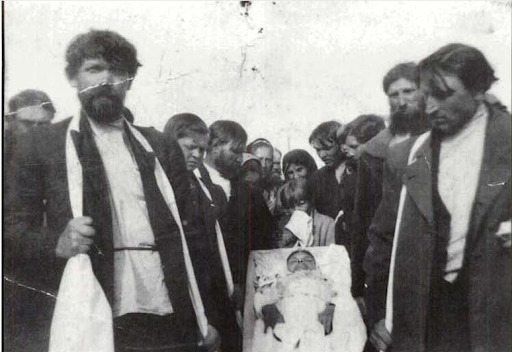The Russians Who Left Northern Utah

https://collections.lib.utah.edu/ark:/87278/s6dj5f01/419942.
In the arid northwest corner of Utah, there is a ghost town with not much left but the road that leads to it, a few decaying foundations, and a cemetery with two Russian gravestones.
While there have been Russians from different religions who have settled in Utah over the years, a settlement of Molokan Russians in Park Valley is one of the only known Russian enclaves in Utah’s history. “Molokan” is a derivative from the Russian word for “milk drinker.” The Molokans inherited their name in the eighteenth century after breaking away from the Russian Orthodox Church over disagreements about the worship of icons, paying clergyman, and dietary distinctions. Specifically, they chose not to stop drinking milk during fasts such as Lent. Their additional aversion to warfare and military service forced the Molokans out of Russia and into California where the Molokans grouped together to establish themselves economically. Although they were able to provide for themselves, many Molokans felt unhappy in San Francisco--they could no longer pasture and farm and were losing vital pieces of their culture and religion.
Moving to Park Valley was a deliberate choice for this group of Russian migrants. It was their goal to protect their Molokan culture and prevent their children from adopting American habits. Thus, the Molokan Russians chose to migrate from Los Angeles to middle-of-nowhere Utah in 1914. While many stayed in California, a group of over 100 Russians, more than a dozen families, attempted to resume an agrarian way of life in Park Valley. They established a village laid out similarly to a Russian agrarian village and sought to practice their religion in peace. Sadly, after a year of joyful farming and welcoming over eight new babies to the settlement, the Molokan utopian settlement began to crumble.
Lack of water access made living in Park Valley difficult. Their crops would not grow and their animals suffered. Then, before their first year in Utah was over, tragedy struck. In an accident during 1914, Andrew Kalpakov, the leader of the Molokan village, accidently shot his wife while cleaning his gun. A year later, the sister of Kalpakov’s wife died in childbirth. The difficult circumstances of drought and death quickly pushed the Molokans to abandon the settlement.
Only four years later, tax documents note that there was only one Russian living in Box Elder County. While a few families chose to move east toward Logan in Cache Valley, most of the Molokans moved back to San Francisco. Even though Utah’s Russian settlement did not last very long, the Molokan people left an interesting story behind for Utahns to learn and discover.
Images

https://collections.lib.utah.edu/ark:/87278/s6dj5f01/419942.

https://collections.lib.utah.edu/ark:/87278/s6dj5f01/419942.

Molokanes Molokans or Milk Drinkers, Los Angeles. Photograph. Los Angeles, CA: Bain News Service. Library of Congress. Accessed May 22, 2020.